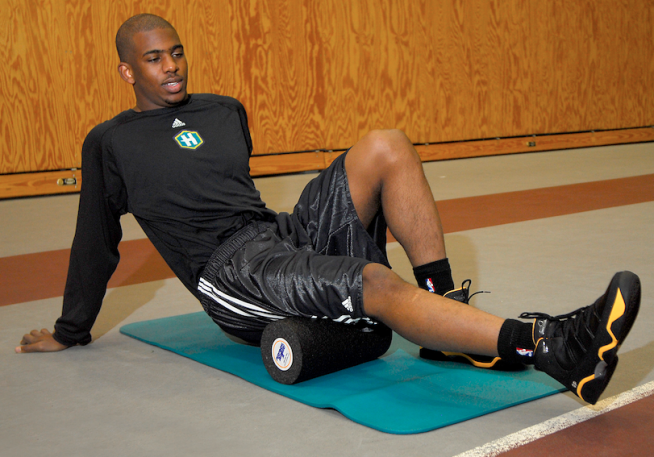The 10-Minute Workout You Should Do Every Day

Sitting slouched forward in a chair: it’s a position we assume way too often throughout each day. It may seem harmless, and even comfortable, but it’s doing a number on our bodies and it may be hurting our sports performance.
Think about your daily routine. You sit in class for about eight hours, probably occasionally resting your head on one of your hands. Then you have an hour or two of practice and/or workouts before heading home to sit at a computer and do your homework. Finally, you finish up the day on the couch watching your favorite show.
Even if you are an athletes, the majority of your day is spent sitting or in a forward hunched position. “Sitting in a chair doing computer work or texting on a phone causes poor postural adaptations,” says Mike Reinold, a world-renowned physical therapist. “You won’t be able to use your body to its full potential because you’ll have lost some mobility and stability.”
RELATED: Pre-Workout Warm-Up Steps You Can't Miss
But sitting is often unavoidable, so the only thing you can do is to fight it. “We need to reverse the poor posture so your body doesn’t adapt to that position,” Reinold advises. “The key is to regularly perform exercises that combat the postures that you put yourself in throughout the day.”
Fortunately, it’s easy to do if you commit to performing the following routine every morning. It only takes 10 minutes. “If you’re taking 20 minutes to do this, then you’re trying too hard,” he adds.
Foam Roll
Benefits: Relieves tight muscles and adhesions that can build up from intense training or limited movement.
How to: Slowly roll over the following muscle groups, focusing on tender areas.
Glutes x 20 seconds each side
Calves x 20 seconds each side
IT Band x 20 seconds each side
Quads x 20 seconds each side
Groin and Hamstrings x 20 seconds
Back x 20 seconds
WATCH: Todd Durkin Shows You How To Foam Roll
Lacrosse Ball Roll
Benefits: Same as foam rolling, but hits areas you can’t get to with a roller.
How to: Slowly roll over the following muscle groups, focusing on tender areas.
Bottom of foot x 20 seconds each side
Back of shoulder x 20 seconds each side
Chest x 20 seconds each side
Foam Roll Thoracic Extensions
Benefits: Relieves a hunched posture with forward rounded shoulders by increasing thoracic spine extension.
How To:
Lie with the middle of your back on a foam roller, hands across your chest, knees bent and feet on the ground.
Arch your back, hinging at the vertebrae under the foam roller. Straighten your back. Repeat for the specified number of reps.
Roll slightly up your spine to the next vertebrae and repeat.
Continue until you reach your upper back.
Sets/Reps: 1x5-10
Foam Roll Thoracic Rotations
Benefits: Improves thoracic spine rotation to ensure that your back is loose in all of its intended ranges of motion.
How To:
Lie with the middle of your back on a foam roller, knees bent and feet on the ground. Extend your arms straight in front of your face with your hands together.
Rotate your hands slightly to your right, as if moving to the one-o’clock position on a clock. Repeat for the specified number of reps.
Roll slightly up your spine to the next vertebrae and repeat.
Continue until you reach your upper back, and repeat by moving your hands to the left.
Sets/Reps: 1x5-10 each side
RELATED: 6 Thoracic Spine Exercises to Improve Mobility
Half-Kneeling Hip Flexor Stretch
Benefits: Your hip flexors tighten from sitting, which causes your pelvis to tilt forward (i.e., anterior pelvic tilt). This eases tension in those muscles.
How to:
Kneel on your right leg with your left foot on the ground and knee at a 90-degree angle. Place your hands on your hips.
Drive your right hip forward. Hold for one count and release.
Sets/Reps: 1x10 each leg
Ankle Dorsiflexion Stretches
Benefits: Improve ankle mobility, which is critical for maximizing your power when running and jumping. Also alleviates a common issue that causes Squat form breakdowns.
How to:
Stand facing a wall in a staggered stance with your right toes an inch away from the wall and your left foot 2 feet behind your right. Place your hands on the wall for support.
Drive your right knee forward until it touches the wall to stretch your calf.
Straighten your leg and repeat.
Sets/Reps: 1x10 each leg
Hip Extension Bridge
Benefits: Engages your glutes and alleviates tight hip flexors.
How to:
Lie on your back with your feet together and flat on the ground, and your knees hip-width apart.
Drive your hips up to the ceiling to form a straight line between your knees and shoulders. Hold for one count.
Lower your hips to the ground.
Sets/Reps: 1x10
WATCH: Strengthen Deep Ab Mucles With the Lewit
Prone Press
Benefits: Again, relieves a tight back (do you get the sense that this is an issue?) and improves extension.
How to:
Lie on your stomach with your hands on the ground next to your shoulders.
Straighten your arm to drive your up and arch your back. Keep your shoulders back.
Lower to the ground and repeat.
Sets/Reps: 1x10
Shoulder W
Benefits: Activates and strengthens the muscles that act on your shoulder blades, which often can become weak and dormant from hunching forward.
How to:
Stand with your feet hip-width apart with your elbows to your sides.
Hold a resistance band with your hands shoulder-width apart and bend your elbows to a 90-degree angle.
Keeping your shoulders back, rotate your arms to your sides to lengthen the resistance band and form a ‘W’ with your upper body.
Return to the start, in control, and repeat.
Sets/Reps: 1x10
RELATED: How to Fix a Forward Head Posture
This article originally appeared on STACK.com: The 10-Minute Workout You Should Do Every Day

